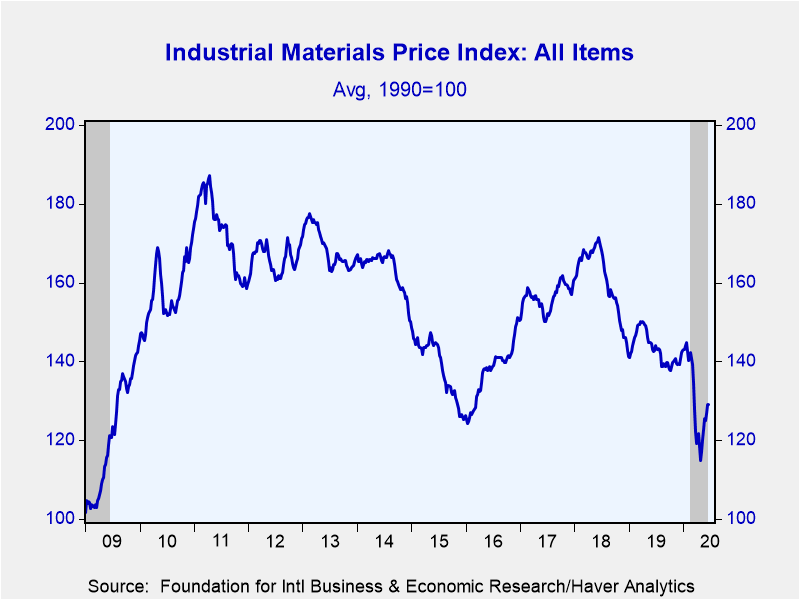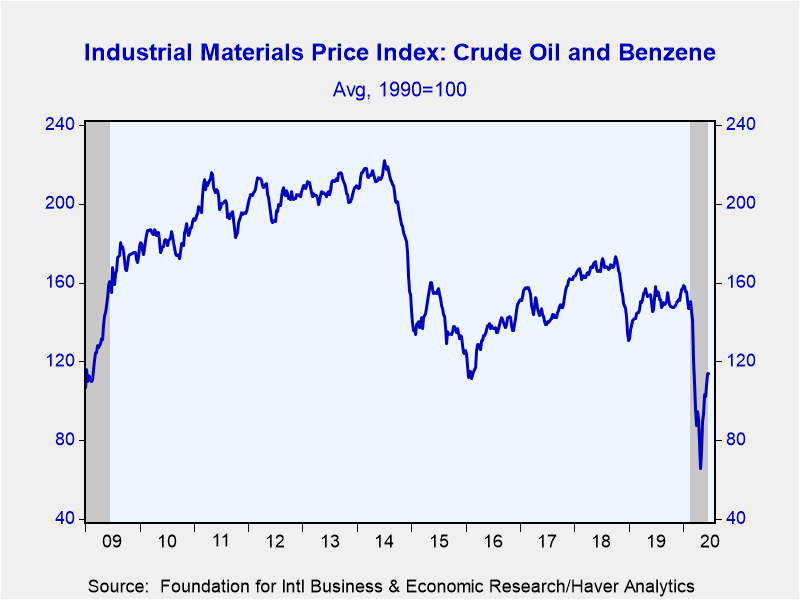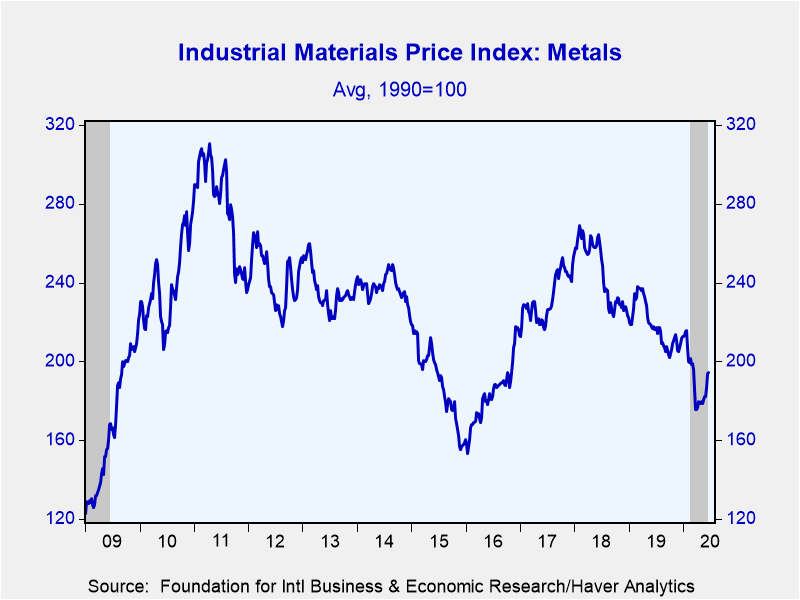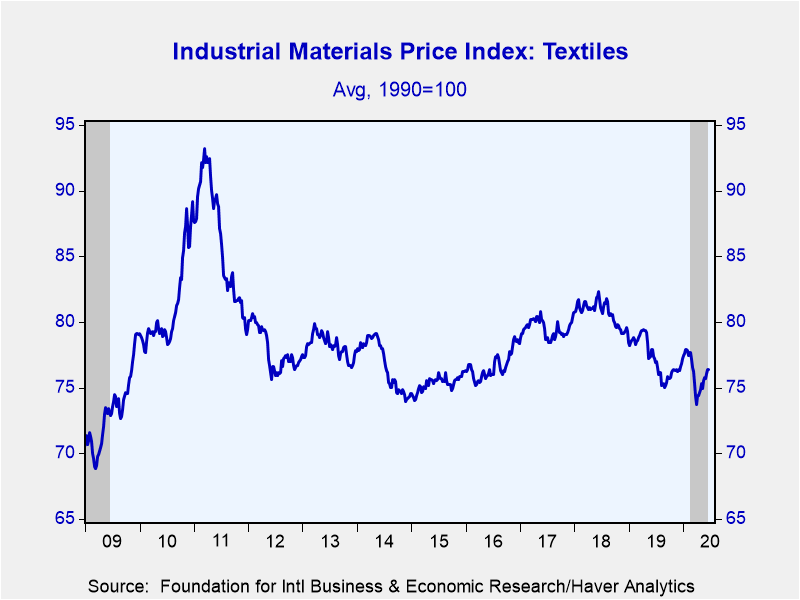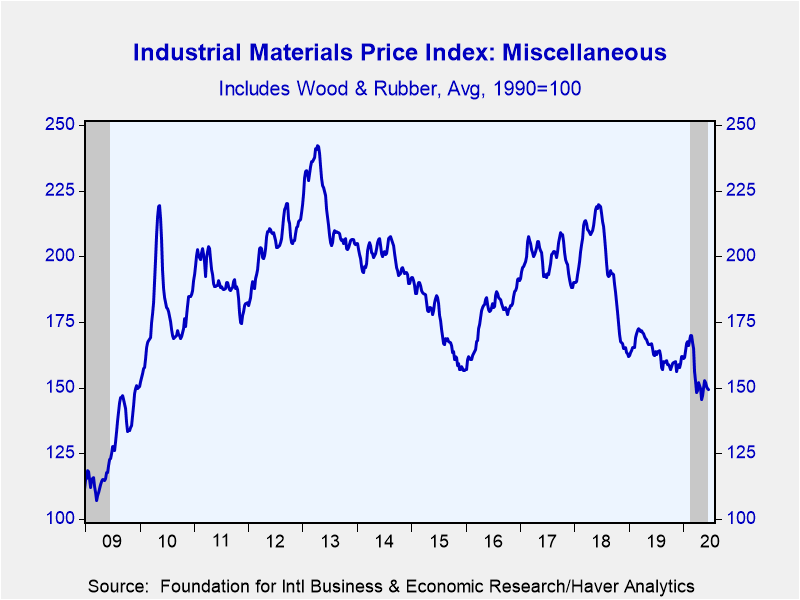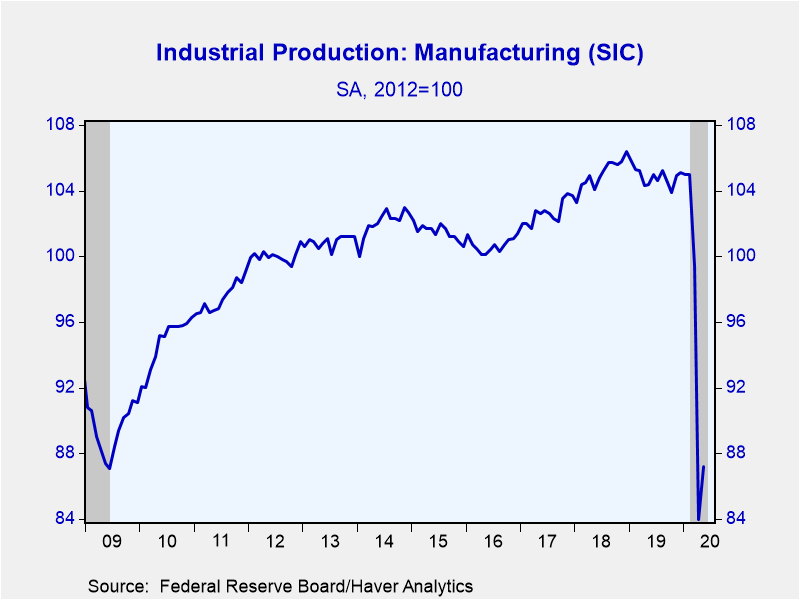 Global| Jun 19 2020
Global| Jun 19 2020FIBER: Industrial Commodity Prices Continue to Improve
by:Tom Moeller
|in:Economy in Brief
Summary
• Prices post broad-based increases. • Crude oil prices lead the upturn. • Metals prices firm. The Industrial Materials Price Index from the Foundation for International Business and Economic Research (FIBER) increased 2.8% during the [...]
• Prices post broad-based increases.
• Crude oil prices lead the upturn.
• Metals prices firm.
The Industrial Materials Price Index from the Foundation for International Business and Economic Research (FIBER) increased 2.8% during the four weeks ended today. The price index has rebounded to the highest level since the second week of March. Nevertheless, prices remained 9.7% lower than twelve months ago.
Strength in the crude oil & benzene group led the price increase in the last four weeks with a 15.4% rise. WTI crude oil prices improved to $37.42 per barrel, up from $25.28 in the middle of May. Prices remained down, however, from a high of $61.92 in the first week of January. Prices of the petro-chemical benzene rose 24.2% in the last four weeks but remained down by roughly one-half y/y. Excluding crude oil, industrial commodity prices rose 2.0% during the last four weeks but fell 8.2% during the last year.
Prices in the metals group improved 6.8% during the last four weeks as the cost of copper scrap rose 8.6% and lead prices increased 7.9% (-7.0% y/y). Aluminum prices strengthened 7.7% while steel scrap prices gained 5.3%. The price of zinc edged 0.2% higher in four weeks but fell 22.4% y/y. Prices in the textile group posted a modest 0.8% increase but cotton prices strengthened 3.0%. This gain was accompanied by a 2.6% rise (3.7% y/y) in the cost of burlap which is used for sacks, bags and gardening.
Working lower were prices in the miscellaneous group which were off 2.3% in the last month. The cost of tallow (used for food preparation) fell 29.1% in four weeks (-17.3% y/y) and reversed its earlier increases. Framing lumber prices rose 4.0% in four weeks but the cost of plywood held steady (-2.4% y/y). Natural rubber prices increased 9.8% over the last month.
Improved activity in the factory sector is an underpinning of the rise in industrial materials prices. Industrial output increased 3.8% in May (-16.5% y/y) following a 15.5% April decline. During the last ten years, there has been a 54% correlation between the y/y change in industrial commodity prices and the y/y change in factory sector production.
Commodity price data can be found in Haver's DAILY, WEEKLY, USECON and CMDTY databases.
COVID-19 Stuns U.S. and Tenth District Economies, but Both Show Signs of Stabilization from the Federal Reserve Bank of Kansas City is available here.
| FIBER Industrial Materials Price Index (%) | 1-Mth | 3-Mth | 6-Mth | 12-Mth | 2019 | 2018 | 2017 |
|---|---|---|---|---|---|---|---|
| All Items | 2.8 | 0.9 | -9.4 | -9.7 | 1.1 | -12.0 | 6.7 |
| Excluding Crude Oil | 2.0 | -0.9 | -7.2 | -8.2 | -0.6 | -11.1 | 4.9 |
| Textiles | 0.8 | 1.4 | -0.6 | -1.0 | -1.6 | -2.8 | 3.0 |
| Cotton (cents per pound) | 3.0 | 5.5 | -11.2 | -8.7 | -6.6 | -9.2 | 9.8 |
| Metals | 6.8 | 4.8 | -8.2 | -10.0 | -4.3 | -12.2 | 18.6 |
| Aluminum ($ per metric ton) | 7.7 | -3.8 | -10.9 | -10.0 | -6.5 | -12.7 | 26.0 |
| Copper Scrap (cents per pound) | 8.6 | 11.2 | -6.6 | -1.8 | 3.5 | -16.1 | 29.3 |
| Steel Scrap ($ per ton) | 5.3 | -1.4 | -11.3 | -9.8 | -0.8 | 2.3 | 16.8 |
| Crude Oil & Benzene | 10.1 | 4.8 | -27.3 | -25.3 | 20.2 | -20.0 | 8.1 |
| Crude Oil (WTI, $ per Barrel) | 15.4 | 36.8 | -38.2 | -30.6 | 35.5 | -24.4 | 10.9 |
| Miscellaneous | -2.3 | -4.4 | -7.7 | -8.0 | -0.0 | -14.8 | -0.5 |
| Framing Lumber ($ per 1000 board ft.) | 4.0 | 16.0 | -9.5 | 11.3 | 22.6 | -23.1 | 20.0 |
| Natural Rubber (cents per pound) | 9.8 | 3.2 | -0.3 | -18.6 | 10.7 | -4.1 | -29.6 |
Tom Moeller
AuthorMore in Author Profile »Prior to joining Haver Analytics in 2000, Mr. Moeller worked as the Economist at Chancellor Capital Management from 1985 to 1999. There, he developed comprehensive economic forecasts and interpreted economic data for equity and fixed income portfolio managers. Also at Chancellor, Mr. Moeller worked as an equity analyst and was responsible for researching and rating companies in the economically sensitive automobile and housing industries for investment in Chancellor’s equity portfolio. Prior to joining Chancellor, Mr. Moeller was an Economist at Citibank from 1979 to 1984. He also analyzed pricing behavior in the metals industry for the Council on Wage and Price Stability in Washington, D.C. In 1999, Mr. Moeller received the award for most accurate forecast from the Forecasters' Club of New York. From 1990 to 1992 he was President of the New York Association for Business Economists. Mr. Moeller earned an M.B.A. in Finance from Fordham University, where he graduated in 1987. He holds a Bachelor of Arts in Economics from George Washington University.


